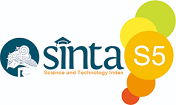Indonesian Teaching Factory: The Recent Breakthrough in Education at Vocational High Schools
Abstract
Keywords
References
Alptekin, S. E., Pouraghabagher, R., Mcquaid, P., & Waldorf, D. (2001). Teaching Factory. Proceedings of the 2001 American Society for Engineering Education Annual Conference & Exposition. https://digitalcommons.calpoly.edu/ime_fac/17/
Arifin, Z. N. (2014). Model Teaching Industri PNJ. https://perpustakaan.pnj.ac.id/readmore/5ee2f30690e21444815e3ec5/model-teaching-industri-pnj
BPS. (2020). Keadaan Ketenagakerjaan Indonesia Februari 2020. https://www.bps.go.id/pressrelease/2020/11/05/1673/agustus-2020--tingkat-pengangguran-terbuka--tpt--sebesar-7-07-persen.html
Direktorat PSMK. (2017). Strategi Implementasi Revitalisasi SMK: Vol. I. Direktorat PSMK.
Direktorat SMK. (2021). Data Pokok SMK 2021. https://datapokok.ditpsmk.net/
Hidayat, D. (2011). Model Pembelajaran Teaching Factory Untuk Meningkatkan Kompetensi Siswa Dalam Mata Pelajaran Produktif. Jurnal Ilmu Pendidikan, 17(4), 270–278. http://journal.um.ac.id/index.php/jip/article/view/2729
Pemerintah Indonesia. (1990). PP 29/1990 tentang Pendidikan Menengah (pp. 1–20). https://jdih.kemdikbud.go.id/detail_peraturan?main=3135
Pemerintah Indonesia. (1997). SK_Mendikbud_no_323_U_1997_ttg_PSG (pp. 1–14). https://www.scribd.com/document/378447379/SK-Mendikbud-no-323-U-1997-tentang-PSG-docx#
Pemerintah Indonesia. (2003). UU 20/2003 tentang Sistem Pendidikan Nasional (pp. 1–26). https://pusdiklat.perpusnas.go.id/regulasi/download/6
Pemerintah Indonesia. (2005). PP 19/2005 tentang Standar Nasional Pendidikan (pp. 1–95). https://www.regulasip.id/book/741/read
Pemerintah Indonesia. (2016). Inpres 9/2016 tentang Revitalisasi SMK. https://www.kemdikbud.go.id/main/index.php/files/download/e451d9ec3a04121
Prosser, C. A., & Allen, C. R. (1925). Vocational Education in a Democracy. Century Co.
Rojewski, J. W. (2009). A Conceptual Framework for Technical and Vocational Education and Training. In International Handbook of Education for the Changing World of Work. Springer Netherlands. https://doi.org/10.1007/978-1-4020-5281-1
Sudira, P. (2016). TVET Abad XXI Filosofi, Teori, Konsep dan Strategi Pembelajaran Vokasional (1st ed.). UNY Press.
Sugiyono. (2022). Metode Penelitian Kuantitatif, Kualitatif dan R&D. Alfabeta.
DOI: https://doi.org/10.20961/ijcee.v10i1.94395
Refbacks
- There are currently no refbacks.
Copyright (c) 2024 Indonesian Journal Of Civil Engineering Education

This work is licensed under a Creative Commons Attribution-ShareAlike 4.0 International License.




3.png)
6.png)


7.png)